You are reading the older HTML site
Positive Feedback
ISSUE
3
Sunier on Hi-Res, Part 2 (with a little help where noted)
(John Sunier, long-time audiophile journalist and reviewer, has been a member of the Positive Feedback community for ten years. As editor of Audiophile Audition (www.audaud.com) and an "Editor of the Round Table," John and company will be contributing to PF Online by allowing the use of his and fellow audaud.com contributors' hi-res audio reviews.)

Billy Joel, Fantasies & Delusions - Music for solo piano
Richard Joo, piano
Sony Classical Columbia stereo SACD-only CS 85397
Yes, this is not only the same pop singer-songwriter Billy Joel, but the same
album I reviewed 11 months back in our Classical CDs section. Only now it’s an
SACD-only release. Back then I felt the ten piano pieces were nearly all in the Romantic
vein of Schubert and Schumann, sometimes seeming almost to be quoting from them. Yet
others echoed a bit of Beethoven or Mozart. Three waltzes are perhaps influenced by Brahms
and Chopin. I hadn’t heard the album since then and this time around I listened
really closely, late at night. Also, my system is better tweaked now, including an
extensive mod on my stereo SACD player, the Sony 9000ES. Back then the pieces sounded like
forgettable, rather bloodless salon music. Now, whether due to the improved resolution,
better playback quality or just increased familiarity with the music, Joel’s pieces
still sound derivative, but now many of them sound like Rachmaninoff rather than Schumann!
The emotional communication of the far-ranging dynamics is strong and I genuinely enjoyed
them this time around. Well, being lazy I’ll just paste in here the rest of my
original review to save your having to go to our search engine, OK?:
Joel selected a better pianist than himself to record the works and the session was held
in Vienna because of the musical/philosophical connections for him. He alludes in his own
notes to ghosts or spirits—that there is something in the atmosphere in Vienna that
connects one to this sort of music. That connected me with the recordings by Rosemary
Brown of some years back who claimed to have a string of famous composers such as Schubert
and Beethoven dictate new piano pieces to her from the Beyond. Joel's pieces remind me
strongly of Brown's - having many qualities undeniably of the particular composer in
question but still sounding like that composer on a rather "off" day. The most
original aspect of this CD is the cover art—an accurate imitation of the front of the
G. Schirmer piano music collections which every piano student has carried around and
struggled with. John Sunier
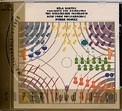
Bela Bartok, Concerto for Orchestra; The Miraculous Mandarin
New York Philharmonic/Pierre Boulez
Sony Classical SACD only SS 87710
The Concerto for Orchestra was considered one of the classical quadraphonic
must-haves back in l972. I still have the SQ LP somewhere but couldn’t put my hands
on it for this review. Thomas Shepard was the original producer and he tried to put the
listener in the middle of the orchestra to spotlight even more than Bartok’s original
score already did the various instrumental sections that are featured in this sort of
successor to Britten’s Young Person’s Guide to the Orchestra. I
received an email from a reader who complained that this was basically a
three-front-channels recording similar to the Everest surprise I covered a couple months
back that was labeled multichannel but had absolutely no signal in the surrounds. However,
I find the surround channels to be fairly normal for recent multichannel orchestral CDs
that are not trying to put the listener in the middle of the band. Perhaps in mixing it
was decided to minimize the exaggerated surround effects of the original four-channel
tapes, keeping in mind that there are no longer serious losses of separation a la SQ and
QS, since each channel is now discrete. The Concerto is right up there with the
preferred choices of this exciting modern work and the surround makes it easier than ever
to isolate the special sounds of each instrumental section even after they have been
melded together for the big finish. The suite from the Mandarin ballet is a good
introduction to a strange work steeped in a scenario of sex and death, but I prefer the
recent CD version by the Lyon Orchestra that I review this issue in the Classical section.
John Sunier
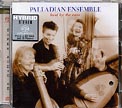
The Palladian Ensemble, Held By the Ears
Pamela Thorby, recorders; Rachel Podger, violin;
Susanne Heinrich, bass viol; Wm. Carter, guitar/lute/theorbo
Linn Stereo SACD CKD 168
This sparkling hi-res disc stuck me as similar to the many chamber-ensemble Baroque albums
on the Dorian label, but somehow it resonated with me even more successfully. Usually an
entire album of such intimate early music is a stretch for my ears unless it features
harpsichord prominently or the music of one of my favorite Baroque composers such as
Zelenka or Scarlatti. Being entirely instrumental helped, as well as the fact that the
Palladian Ensemble takes a dashing and exuberant approach to this music, not allowing
themselves to be weighed down by overly hewing to academic/musicological correctness. In
fact, the four players sound like they have spontaneous connections that reminds one of
the interplay of the best jazz quartets. Add to this the repertory on this SACD, which is
mostly music of an obscure Italian composer who was active in England in the 17th
century—Nicola Matteis. The subtitle of this album comes from a contemporary
description of one of the violin virtuoso/composer’s performances. He qualifies as
creating some of the wildest music of the period—in a class with Gesualdo, Zelenka
and Kuhnau. When they first began rehearsing some of his pieces, one of the Palladian
players observed that it sounded a bit like rock n’ roll. Matteis was also known for
his improvisation skills, his variations on folk tunes, and the immense volume of his
compositions. The Palladians have chosen some of the very best and mixed them with
anonymous and their own variations on various Scottish airs. A delightful musical
discovery enhanced via the crystalline reproduction of this DSD recording. John
Sunier
Two Sides of Schubert in our next hi-res disc pair...
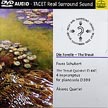
Schubert, The Trout Quintet; Four Impromptus for piano solo
D899 - Alvarez Quartet & Carmen Piazzini, p.
Tacet Multichannel DVD-Audio DVD 106
An energetic and lively version of the familiar Schubert quintet, with a Frankfurt-based
quartet and a near-anonymous pianist—whose solos were also familiar to me since I
once played some of the Impromptus as a piano student. Tacet omitted any listing of the
pianist on either the jewel box credits or in the note booklet, and neither is her photo
included with the quartet’s inside - they’re standing in front of a piano! After
much search I found a paragraph bio of her buried in the middle of the notes. If I were
Carmen I’d be pizzed. Tacet dubs their DVD-As "Real Surround Sound." What
they mean is they are applying pop studio techniques to classical music in surround and
not tying themselves to the conservative approach of putting the musicians up front and
having only subtle ambience of the venue in the surround channels. There are even diagrams
much as Telarc and others include with surround discs, showing the exact layout of mikes
and instruments - or in this case of the listener’s head and the instruments. For the
Quintet the piano is dead ahead in the center channel (woe to those
anti-home-theater surround fans who lack a center channel). The violin occupies the left
front, the viola the right front, the bass the left rear and the cello the right rear. You
can’t help but become highly involved in the music this way. In some ways it is
similar to binaural listening but without the headphones. So far I’ve found it
fascinating and great classical demo material for newbies to SSfM [Surround Sound for
Music].
However, the solo piano tracks by Ms. Piazzini employ an entirely different alignment
that may seem just plain perverse to some listeners - the piano is directly behind you and
the front three channels carry only the hall ambience. Producer Andreas Spreer argues
among other things that this will be more appropriate if you have a DVD player in your
car. Why? Because with a normal surround recording the piano would seem to be sitting on
the hood of your car. Uh, huh. Well, one of the many advantages listed early in the game
for the new multichannel media was the flexibility to use the six channels available in
any way the producers/engineers/mixers might see fit. So let’s celebrate such
initiative! At least I don’t have to change half of my amp and speaker connections
plus moving speakers, as with some of the other hi-res alternatives to 5.1 (which I will
eventually get to in upcoming issues).
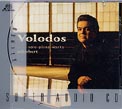
Schubert, Sonata in E Major D.157 (unfinished), Sonata in G Major
D.894, Der Mutter und der Bach (arr. by Liszt)
Arcadi Volodos, piano
Sony Classical Stereo SACD-only SS 89647
Russian pianist Volodos has blazed a highly successful concert career since his New York
debut in 1996. His few recordings have won him awards and honors from many publications
and organizations. We covered his Rachmaninoff Piano Concerto No. 3 on SACD
recently. This latest disc features three Schubert works which are not as virtuosic as
Rachmaninoff but have their own unique nature. Although Liszt championed Schubert’s
music and created this arrangement of one of his Schone Mullerin lieder, the thing to
avoid is imposing Lisztian or Chopinesque virtuoso nuances onto Schubert. Volodos carries
this out and allows the lovely and abundant Schubertian melodies to sing out. The G
Major is Schubert’s longest sonata, of symphonic proportions, but Volodos holds
it together from start to finish with unflagging forward motion. The piano sound is of
great clarity and specificity not heard on most 44.1 CDs and the surrounding ambience is
broad and natural. Playback via Pro Logic II imparts a very subtle improved image of the
hall; I don’t see how a 5.1 version could be much better. An interesting acoustic
note is that this was the very last recording made in the acclaimed "perfect
acoustics" of Vienna’s Sofiensaal. It burned to the ground in August of 2001.
John Sunier
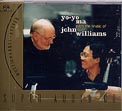
Yo-Yo Ma, cello/Recording Arts Orchestra of Los Angeles/John Williams
Sony Classical multichannel SACD-only SS 89670
The overall album title here is Yo-Yo Ma Plays the Music of John Williams. The two musicians have been friends for years and have performed some of the standard cello concertos together in concert. The major work of the Cello Concerto here resulted from a suggestion of conductor Seiji Ozawa. It was first performed in 1994 at Tanglewood and is in four non-stop movements. All of them provide plenty of opportunity for Ma’s virtuosity to be demonstrated. The second movement is a Blues, and Williams reports he was influenced by the ghosts of Ellington and Strayhorn in this section. The Elegy grew out of some of the material Williams had penned for the soundtrack of the movie Seven Years in Tibet, for which Ma was cello soloist. Both these works are less tonal and accessible than Williams’ film score music, but Ma’s glistening cello tones seem to hold things together. In Heartwood Williams was inspired partly by a collection of tree photographs given him by a friend, and partly by his memories of listening to the moody and impressionistic arrangements of the Claude Thornhill Orchestra in the 30s and 40s. The surrounds provide a subtle feeling of the concert hall or studio—no details are given on the recording venue, and Ma’s cello is dead center. So I hope you’re not saddled with a center channel speaker whose timbre is entirely different from the other four main speakers - as so many are. John Sunier
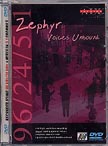
Aix Records DVD-A & V AIX 80012
Again one cannot avoid being impressed by the work and effort that goes into each Aix Records DVD-A; no other label is giving purchasers so many options for their money, and these are all brand new recordings and videos—not recycled stuff from the past. This session in the Aix studio brought a dozen of the best singers on the West Coast to perform 23 a cappella selections ranging from early polyphony to a song by William Schuman using words of Walt Whitman. I usually begin auditioning by viewing the video side of the DVD, which is a complete video record of the entire concert. This one lacks a feature of some of the AIX discs with two different viewing angles for the video—such as the entire orchestra or just closeups of the conductor. However it does include two different "audio angle" choices—one that puts the listener in the audience as in a typical recording approach, and another that gives a "stage" presence in this case surrounded by the circle of singers. You have a choice of either Dolby Digital 5.1 or stereo. I optioned for the former and found that seeing the singers performing—arrayed in a large circle—added a great deal of interest to this music which is not necessarily my first choice for listening—especially the predominately early music part of the program. The Dolby surround track was created and mixed in 24bit/96K from start to finish; it was so good I heard only minimal improvement in clarity with the 96K track on the DVD-A side of the disc, but on that side of the disc you had only a single still image for each selection and no more live action video to watch. Some of the "call and answer" play of voices in the madrigals was fun with the spatial displacement of the singers in the circle around the listener. I liked especially the four short songs to Dorothy Parker lyrics and the humorous sound effects and vocal percussion in Freddie Mercury’s "Seaside Rendezvous." Seeing the smiles of the singers in performing this delightful track greatly enhanced the musical experience. John Sunier
First two DVD-As from an extensive new series recorded in Hungary...
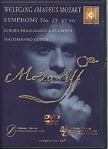
Mozart, Symphony No. 25
KV 183 Europa Philharmonia Budapest/Maximianno Cobra
Hodie DVD-A (no number)
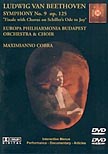
Beethoven, Symphony No. 9
Soloists/Europa Philharmonia Budapest Orch. &
Choir/Maximianno Cobra
Hodie DVD-A and V (2 discs, no number)
This is only the beginning of the new series from Hodie—the rest includes three DVDs
of various Mozart overtures, which I plan to cover next issue. Packaging is in standard
DVD-video boxes, and a booklet is enclosed in all the albums with an essay by
French-Brazilian conductor Cobra on "Tempo, Space and Music." The Europa
Philharmonia Budapest Orchestra and Choir was founded by Cobra in 1999 and brought
together the elite of Hungary’s instrumental and vocal musicians. The Mozart receives
here a spry and jovial treatment plus excellent sonics no matter which of the three
options you choose for playback. The 51-minute running time exceeds other recordings of
the work by several minutes, but it doesn’t sound draggy. The second side of the DVD
is designed to play on all DVD players, and includes both Dolby Digital 5.1 and DTS 5.1
plus Stereo PCM—all three of these at 48K sampling rate. There is a single
illustration for each movement and the artwork and titles change for each. Hodie refers to
this as a slide show; I kept looking for more images but none appeared. The 48K DTS is
very good and the 96K MLP six channel surround is somewhat better, but I would be hard put
to identify a further improvement on the front channels only of the 192K sampling
option.
The Beethoven Ninth is a more major project all around. There are two
discs—Disc 1 is double sided, with the 192K stereo option on one side and the 96K
6-channel surround option on the other side. Disc 2 boasts a 48K Dolby Digital 5.1
soundtrack, but on this the entire full motion widescreen video of the performance by the
Philharmonia is seen. A multi-miked approach fed a 96-channel console and recorded onto a
48-track recorder. Conductor and producer Cobra wanted the aural effect of the listener
being placed right in the middle of the orchestra. The studio was covered in black fabric
so that the musicians and choir stand out starkly The camerawork is good, although all the
performers seem to be bathed in a sort of reddish-yellow light. Sonic placement of solo
instruments as well as vocal soloists doesn’t always agree with what is viewed on the
screen. For example, at the start of the last movement "Ode to Joy" choral
section the vocal soloist is on the left of the side screen, yet his voice is clearly
heard from the front right speaker. The other over-riding and more major problem here is
that this is the slowest Ninth I have ever heard. It almost sounds as though it is a
rehearsal at half speed to work out all the details more easily. The choral climaxes of
the "Ode to Joy" don’t seem joyful at the lugubrious tempo. One is tempted
to get behind the orchestra and give them a push. The video disc also includes a
beautifully-photographed PBS-style documentary on Beethoven’s life at the time of the
composing of the Ninth, narrated by conductor Cobra in his inimitable thick
accent and alternate English vocabulary. The overall notes for the entire set state that
there is a similar documentary with each DVD album, but after a very thorough search of
the Mozart symphony disc I failed to come up with one there. It may be there someplace but
due to the continually frustrating navigation/programming of nearly all DVD-As it
didn’t make itself apparent to me. John Sunier
